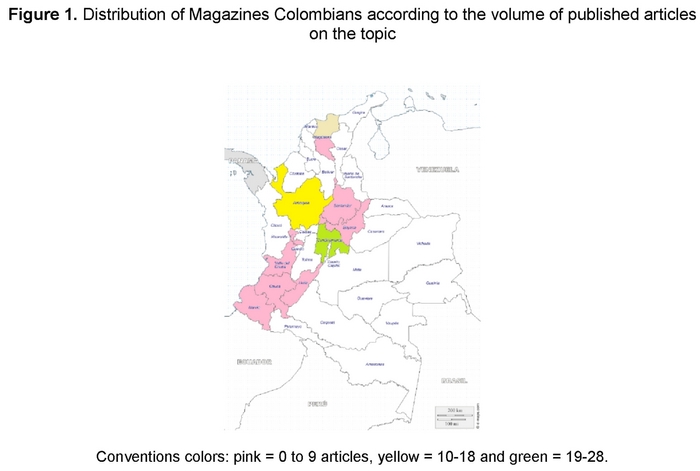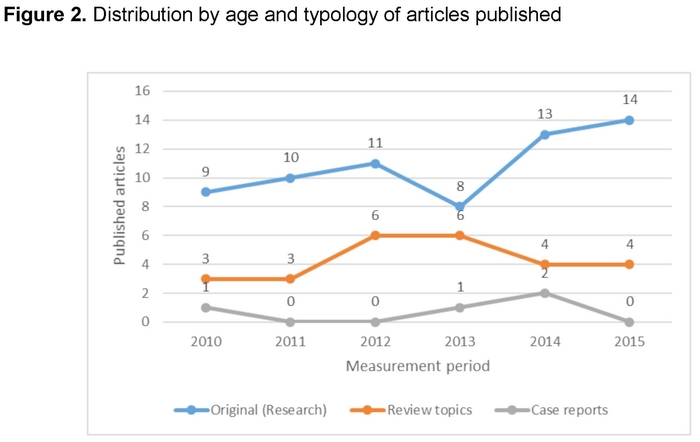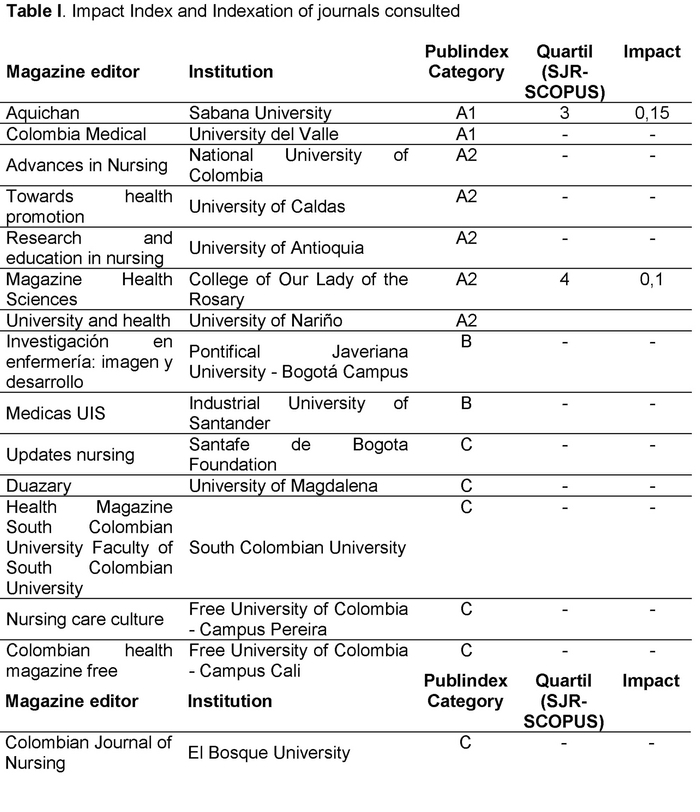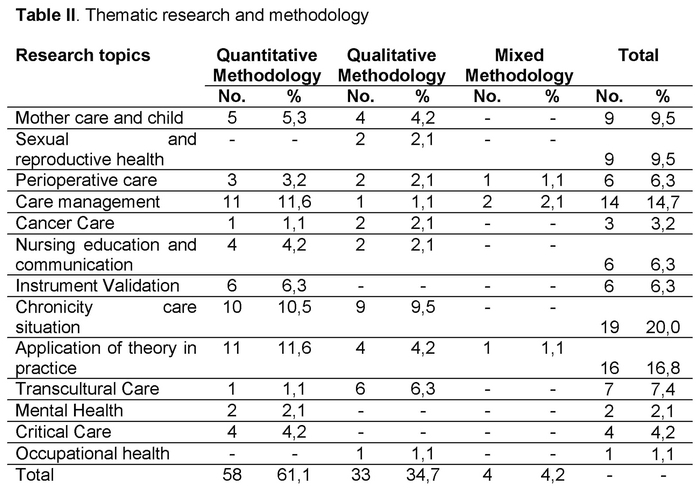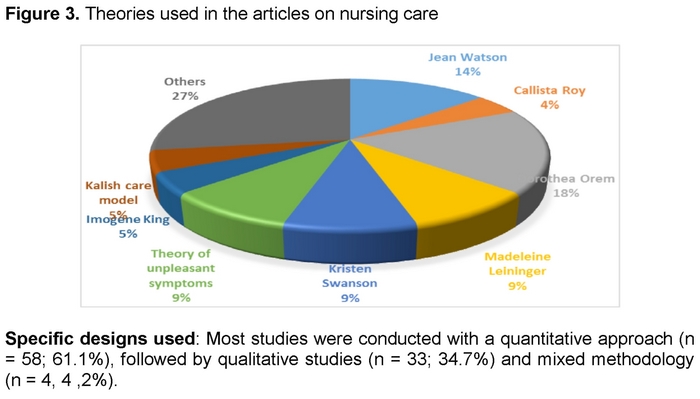Meu SciELO
Serviços Personalizados
Journal
Artigo
Indicadores
-
 Citado por SciELO
Citado por SciELO -
 Acessos
Acessos
Links relacionados
-
 Citado por Google
Citado por Google -
 Similares em
SciELO
Similares em
SciELO -
 Similares em Google
Similares em Google
Compartilhar
Enfermería Global
versão On-line ISSN 1695-6141
Enferm. glob. vol.15 no.44 Murcia Out. 2016
REVISIONES
Bibliometric analysis of articles on nursing care published in Colombian magazines
Análisis bibliométrico de los artículos sobre cuidado de enfermería publicados en revistas colombianas
Camacho Rodríguez, Doriam Esperanza*; Oviedo Córdoba, Haidy Rocío**; Ramos de la Hoz, Ediltrudis*** and González Noguera, Tatiana Cecilia****
*Nurse. Magister in Management of quality, safety and the environment. Research Coordinator. Universidad Cooperativa de Colombia Sede Bucaramanga. E-mail: doricama@yahoo.es
**Nursing Magister. Dean Faculty of Nursing. Universidad Cooperativa de Colombia. Sede Santa Marta.
***Nursing Magister. Professor School of Nursing. Universidad del Magdalena. Colombia.
****Nursing Magister. Professor School of Nursing. Universidad del Magdalena. Colombia
ABSTRACT
Objective: To accomplished a bibliometric analysis of articles published on nursing care in Colombian journals.
Materials and Methods: Descriptive y retrospective bibliometric study. It was analyzed 95 articles published in 18 Colombian indexed journals in Publindex during the years 2010 to 2015. The search was conducted by the care descriptors, nursing models, nursing theory. The descriptive analysis was performed using an Excel spreadsheet and bibliometric indicators of productivity, citation, content and Methodology.
Results: An increase in publishing in the last 5 years is observed, being the original research articles the ones which are published the most and the institutions that published the most are Universities from Bogota and Antioquia. According to the citation indicators the index price was 37.45%, while the isolation rate was 33.67% and self-citation index was 1.85%. On indicators of collaboration, co-authorship index was 2.7 and the institutional collaboration index was 1.3.
Conclusions: An increase in scientific research about Nursing in Colombia is observed, however, it is necessary to expand cooperation indicators.
Keywords: bibliometrics; nursing care; publicactions, (Source: MeSH).
RESUMEN
Objetivo: Realizar un análisis bibliométrico de los artículos sobre cuidado de enfermería, publicados en revistas Colombianas.
Materiales y método: Estudio bibliométrico descriptivo, retrospectivo. Se analizaron 95 artículos publicados en 18 revistas colombianas indexadas en Publindex, durante los años 2010 a 2015. La búsqueda se realizó mediante los descriptores: cuidado, modelos de enfermería, teoría de enfermería. El análisis descriptivo se realizó mediante una hoja de Excel y se analizaron los indicadores bibliométricos de productividad, citación, contenido y metodológicos.
Resultados: Se observa un incremento en la publicación en los últimos 5 años, siendo los artículos de investigaciones originales los que más se publican y las Instituciones que más publican son las Universidades de Bogotá y Antioquia. En relación con los indicadores de citación, el Índice de Price fue de 37,45%, en tanto que el índice de aislamiento fue de 33,67% y el índice de auto citación fue de 1,85%. Sobre los indicadores de colaboración, el índice de coautoría fue de 2,7 y el índice de colaboración institucional fue de 1,3.
Conclusiones: Se observa un incremento en la producción científica de Enfermería en Colombia, no obstante, se hace necesario ampliar los indicadores de colaboración.
Palabras clave: bibliometría, cuidado de enfermería, publicaciones, (Fuente: DeCS).
Introduction
Nursing research in Colombia has increased in recent years due to factors such as the diversity of graduate programs, the generation of scientific societies and the increase spaces for scientific publications This scientific research increment is necessary to legitimize nursing as a profession, by means of developing a body of knowledge necessary for the provision of health care to the population(2), however, not all research papers are published because exercise publishing research Results are linked to graduate programs(3). Given the importance of streamlining nursing practice and adding new knowledge to care based on evidence, it is essential for the profession to publicize research Results(4), using the publication in refereed journals and seeking strategic to strengthen research groups alliances(5).
One strategy for determining progress in research in a given area is performing bibliometric studies; in this regard, there were found several research article on specific topics were analyzed such as geriatrics(6), cardiac and coronary emergencies(7), intensive and coronary care(8) and magazines on Nursing research, such as the journal of Nursing in Cardiology(9), Cuiden(10) Role of Nursing publications in databases internationally as ISI web of Science(12) but not specifically from Colombian magazines. Nursing in Colombia has produced research on various topics; however, the interest of this study is to investigate production in the specific topic of nursing care. In order to determine the research progress in nursing care we appeal to the analysis of bibliometric indicators, which allows evaluating, determine and provide information on the Results of growth in the research process in any field of science(13).
For the bibliometric analysis can be used Spinak classification (1998), that classifies them into two groups, indicators of activity and impact. Activity indicators represent the actual state of science and include number and distribution of publications, productivity, dispersion of publications, collaboration in publications, half-life of the citation or aging connections between authors, among others, while among impact indicators are evaluating highly cited papers "Hot papers" and the impact factor(14), employed by the publication of the Science Citation Index -SCI-(15). Another classification is Cano and Well (1999) dividing the indicators in personal, productivity (rates collaboration, multi authorship and institutional), citation (impact factor journals and indexes of obsolescence, immediacy, themed present, isolation and self-citation), indicators (thematic or contextual descriptors) content and Methodological indexes (theory from or for which specific works and designs used)(16). Some of the most commonly used bibliometric indicators are the two obsolescence of Burton and Kebler, the Price Index or percentage of referrals with less than 5 years old and the isolation index (insularity) or percentage of References corresponding to publications from the same country of publication(17).
Materials and Methods
A retrospective, descriptive bibliometric study of scientific publication of Colombian nursing journals published from 2005 to 2015 was conducted for articles published in journals indexed in 18 Colombian Publindex, 9 nursing and 9 of the analyzed area health, during the years 2010-2015, through consultation on the web pages of each magazine. The search was performed using the care, nursing models, nursing theory, being 95 articles that met the requirement of the presence of the descriptor in the title of the descriptors.
The data were analyzed in a spreadsheet Excel with different variables to analyze, including the magazine, theme, Institution of affiliation of the authors, article type, year of publication, number of authors, subjects of study and approach to the study. Finally, descriptive statistics were used to analyze the Results. Bibliometric indicators analyzed and used were productivity, citation, content and Methodology, as classified by Cano and Bueno(16).
Results
95 articles published in 18 journals indexed Colombia, of which 22% (n=21) are of foreign origin, from Brazil (n=7; 7.4%) were analyzed, Mexico (n=7; 7; 95 articles published in 18 journals indexed Colombia, of which 22% (n=21) are from foreigners, from Brazil (7.4% n=7) were analyzed 4%), Chile (n=4; 4.2%) and Spain (n=3; 3.2%). The Region of Colombia where more articles on the subject found was Bogotá, because there are 6 of the 18 journals analyzed, being higher production in Aquichán Magazines (n=28; 27%), Nursing Research, Image and development (n=13; 12%) and Advances in Nursing (n=11; 10%). Moreover, most items were found on the specific Nursing Magazines (n=88; 84%), while the remaining percentage were published in journals in the field of health (Figure 1).
In Colombia, the publication of articles on the specific topic of nursing care has increased over the years, with a greater production of original articles (n=65; 68.4%), followed by the review (n=26; 27.4%) and case reports (n=4; 4.2%) (Figure 2).
Indicators of collaboration: from 95 articles analyzed 258 authors were found. The rate of co-authorship or number of firms for work was 2.7, the rate of institutional collaboration was 1.3. In this regard, the institutions with the highest number of publications, according to the affiliation of the first author are in order: National University (n=15; 15.8%), Universidad Javeriana (n=8; 8.4%), University of Antioquia (n=6; 6.3%) and Universidad del Bosque (n=5, 5.3%). Notably health institutions publications were also found as the University Hospital Fundación Santa Fe de Bogota (n=3, 3.2%) and Hernando Moncaleano Hospital of Neiva (n=1, 1.1%). In connection with foreign institutions that have published in Colombia on the subject of care, dominates the Federal University of Rio Grande do Soul, University of Rio de Janeiro, Autonomous University of Nuevo Leon and Universidad de Concepcion of Chile, each with two articles published respectively.
Citation indicators: Index obsolescence or aging was measured through the Price index, which was 37.45%, the isolation rate was 33.67% and the auto index was 1.85 citation %. Similarly, median References, which was 26.7 ±3 was analyzed.
Index impact: the impact factor of the journals consulted revised according SCImago Journal & Country Rank, for journals indexed in Scopus and Magazines category according Plublindex (See Table I).
Content indicators:
thematic or contextual Index: Topics on which further research is carried out are in a situation of chronic care, application of theory in practice and care management (see Table II).
Descriptors: the most commonly used descriptors were nursing (58), nursing theory (11), caregivers (10) and nursing care (8).
Methodological indicators:
Theory from or for which work: In analyzing theories or models of Nursing referred in the research found that applied in its order Dorothea Orem, Jean Watson theory of unpleasant symptoms, Callista Roy, Imogene King and Kalish care model.
Specific designs used: Most studies were conducted with a quantitative approach (n=58; 61.1%), followed by qualitative studies (n=33; 34.7%) and mixed Methodology (n=4, 4 ,2%).
Discussion
Publications on the subject of nursing care in Colombia are concentrated in major journals, such as Aquichán, Nursing Research, development and Image and Advances in Nursing; in fact, in another study in Colombia found that the universities that most published are those which accounts for 62.4% of scientific production and further condition that their authors are among the most productive, among which the Universidad Nacional de Colombia, Universidad de Antioquia, Universidad del Valle, Universidad de la Sabana and Pontificia Universidad Javeriana(12). In this regard, Johnstone (2007) states that if the authors of nursing leave their editorial commitment and publish only in "elite" magazines (many of whom may be from other countries); the capacity of the nursing profession to develop and control the forefront of their disciplinary knowledge could be placed at risk(18).
Traditionally nurses teaching area are the ones who publish in Colombia(19), in fact in this study 90% of the articles were published by linked to universities authors, higher than found in another study in Colombia on publications percentage databases, where 59% of the production is concentrated in universities, although other institutions maintained a significant presence with contributions to scientific production(12). Meanwhile, Alarcon and Astudillo found that 88% of the authors were from academia(1).
Publishing original articles is an indicator that in Colombia research has increased, which is evidenced by the high percentage of original articles or research in this study, similar to that found in another study in Colombia(12).
In analyzing the collaboration rates, it was found that the coauthored rate was 2.7, low compared with what it was found in the study of Chaviano(12) where the index is 6, which represents greater collaboration among authors and that probably it translates into a greater richness in the subject matter of the publication(20).
Regarding the impact factor of journals, it should be noted that only two are indexed in Scopus and therefore have impact factor being low, taking into account that magazines are in quartiles 3 and 4. In this regard, it should be noted there are numerous voices for and against the index measuring impact as magazines conditions vary from country to country, and even from profession to profession. That is why in The United States of America indices for evaluating impact publications area nursing and midwifery were constructed(21).
The topics discussed more frequently in the investigations that led to the items were care in situations of chronicity, application of theory in practice and management of care, this last issue coincides with the findings of Fernandez (2014)(22) and Velez (2014) who also notes that within the thematic lines that have been addressed as a priority in nursing research in epidemiology-health Colombia are found: collective, epistemology, administration and management(5).
Regarding the approach of the investigation, it was found that prevails the quantitative, similar to the Results of a study conducted in Chile, where 80.8% used the quantitative Method, 17.3% were qualitative studies, and only 1.3 % used a mixed qualitative and quantitative approach(1).
Conclusion
There was an increase in the scientific publication on nursing in Colombia, predominantly the publishing of original articles and particularly on an issue that is important for the development of nursing as a professional discipline, as is the application of theory in practice; however, the rate of Institutional collaboration is necessary to increase the rate of co-authorship, as well. It should be noted that there are no specialized publications in Colombia, as in Spain, where are specific publications for nephrology, history of nursing or midwifery(6).
This study presents an overview about publication review on research studies on the subject of nursing care, however, it is necessary to promote the implementation of bibliometric studies on other specific topics of nursing, considering that productivity and quality of research produced by individual researchers, research groups and universities are an important measure of their success and their contribution to the productivity of the economy(23).
Received: January 23, 2016
Accepted: March 26, 2016
References
1. Alarcon , A., Astudillo P. La investigación en Enfermería en Revistas Latinoamericanas. Cienc y enfermería. Universidad de Concepción. 2007;13(2):25-31. [ Links ]
2. Vélez Vélez E. Investigación en Enfermería, fundamento de la disciplina. Rev Adm Sanit Siglo XXI.2009;07(02):341-56. [ Links ]
3. Zavala MOQ, Klijn TP. Internacionalización de la Educación en Enfermería y sus Desafíos. Enferm. glob (online) 2011; 10(24). Disponible en http://scielo.isciii.es/pdf/eg/v10n24/reflexiones1.pdf. [ Links ]
4. Wilkes L, Jackson D. Trends in publication of research papers by Australian-based nurse authors. Collegian. 2011;18(3):125-30. [ Links ]
5. Vélez Álvarez C, Pico Merchán ME, Ariza Olarte C, Castellanos F, Salazar Maya ÁM. Tendencias y agenda de prioridades de investigación en unidades académicas de Educación superior de Enfermería en Colombia. Cienc y enfermería. 2014;20(3):11-20. [ Links ]
6. Jiménez Navascués M. L, Hijar Ordovás CA. Estudio bibliométrico (2001-2009) sobre la enfermería geriátrica y gerontológica en España. Gerokomos. 2012;23(2):55-8. [ Links ]
7. Castro Teijeiro J. Producción científica en enfermería de urgencias cardíacas y coronarias: Análisis de la literatura. Enfermería Glob. 2010; (20). Disponible en http://scielo.isciii.es/pdf/eg/n20/revision1.pdf. [ Links ]
8. Lizarbe Chocarro M. Enfermería en Cuidados Intensivos y Coronarios. Análisis bibliométrico de 180 artículos originales. Enfermería Intensiva. 2007;18(3):126-37. [ Links ]
9. Medina García J, Martínez Casas J. Análisis de la producción científica de la revista Enfermería en cardiología en sus 20 años de edición. Enfermería en Cardiol. 2015;22(64):93-100. [ Links ]
10. García JM, Casas JMM, Leal L marcela R. La comunicación científica de la investigación cualitativa en la Enfermería Iberoamericana incluida en CUIDEN, en el año 2012. INDEX. 2014;8(20). Disponible en http://www.index-f.com/para/n20/pdf/196.pdf. [ Links ]
11. Flores Martín J. Análisis bibliométrico de la revista Rol de Enfermería. Comparativo entre 2000 y 2004. Doc las Ciencias la Inf. 2004;31:17-43. [ Links ]
12. Gregorio-Chaviano O, Méndez-Rátiva CP, González MJP, Guzmán MF. Investigación colombiana en enfermería. Un análisis bibliométrico de su visibilidad en ISI WoS (2001-2013). Enferm Global. 2015; 14 (4): 175-91. [ Links ]
13. Escorcia-Otálora T. El análisis bibliométrico como herramienta para el seguimiento de publicaciones científicas, tesis y trabajos de grado. Pontificia Universidad Javeriana; 2008. Disponible en http://www.javeriana.edu.co/biblos/tesis/ciencias/tesis209.pdf. [ Links ]
14. Spinak E. Indicadores cienciometricos. Ci Inf, Brasília. 1998;27(2):141-8. [ Links ]
15. Camps D. Limitaciones de los indicadores bibliométricos en la evaluación de la actividad científica biomédica. Colomb Med. 2008; 39(1):74-9. [ Links ]
16. Vallejo-Ruiz M. Estudio longitudinal de la producción Española de tesis doctorales en educación matemática (1975-2002). Universidad de Granada; 2005. Disponible en http://hera.ugr.es/tesisugr/15389807.pdf. [ Links ]
17. Escorcia-Otálora, T., Poutou-Piñales R. Análisis bibliométrico de los artículos originales publicados en la revista Universitas Scientiarum (1987-2007).Univ Sci. 2008;13(3):236-44. [ Links ]
18. Johnstone M-J. Journal impact factors: implications for the nursing profession. Int Nurs Rev. 2007;54(1):35-40. [ Links ]
19. Melgarejo LM, Huertas SG. Caracterización de las publicaciones periódicas de la enfermería en Colombia visibles en Internet. Avances en Enfermería. 2011; 29(1):159-68. [ Links ]
20. Camps D. Estudio bibliométrico general de colaboración y consumo de la información en artículos originales de la revista Universitas Médica, período 2002 a 2006. Univ Médica. 2007;48(4):358-65. [ Links ]
21. Crookes PA, Reis SL, Jones SC. The development of a ranking tool for refereed journals in which nursing and midwifery researchers publish their work. Nurse Educ Today. 2010;30(5):420-7. [ Links ]
22. Fernández Camiñas, J. y Regueiro Cabana M. Análisis de la producción científica de la enfermería en España en el año 2012. Cuad atención primaria. 2014;20:78-81. [ Links ]
23. Davidson, P., Newton, P., Ferguson,C., Daly, J., Elliott, D., Homer, C., Duffield, C & Jackson D. Rating and Ranking the Role of Bibliometrics and Webometrics in Nursing and Midwifery. Sci World J. 2014;1-6. [ Links ]











 texto em
texto em 

